
|
|
January 23-30, 2002
The New York AM Dial: East Rutherford/Carlstadt, N.J.
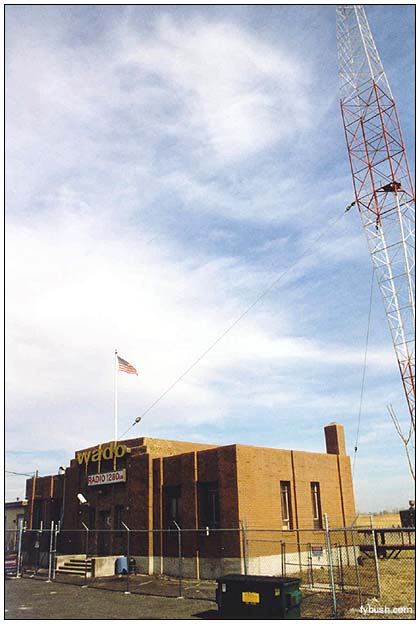 What you see at the
left is a bit of radio history: the transmitter site of WADO,
New York as it appeared in March 1998.
What you see at the
left is a bit of radio history: the transmitter site of WADO,
New York as it appeared in March 1998.
It's radio history for several reasons, beginning with a legacy that dates back at least to February 13, 1934, when stations WAAM Newark and WODA Paterson, which had been sharing time on 1250 kHz (along with a third station, WHBI Newark), joined forces to become "New York's newest radio station," WNEW, operating from this very site on Paterson Plank Road in Carlstadt, N.J., using a transmitter that had belonged to CBS flagship station WABC (860, now WCBS 880) at its old site in Wayne, N.J.
(Your editor believes that WAAM, at least, may have already been using this site before becoming WNEW, but has yet to find confirmation.)
As WNEW, the station on 1250 was a true radio pioneer, giving birth to the disk jockey (in the person of Martin Block's "Make Believe Ballroom") and to all-night programming (Stan Shaw's "Milkman's Matinee"), all emanating from this Blaw-Knox diamond tower.
In March 1941, WNEW moved to 1280, and that December switched facilities with station WOV, which had just moved to 1130 kHz from a site a few miles south in Kearney, N.J.
On this 1280 signal, WOV gave New Yorkers almost two decades of black, Italian and country music programming before being sold in 1959 and becoming WADO. In 1962, WADO bought out WHBI, which had continued to operate Sundays on 1280 for years, and became full-time, changing formats to Spahish-language full-service.
And that's what WADO has been ever since, more or less - at least where programming is concerned.
But now the picture shown above is history in another way. When I took it in 1998, this was one of six sites around the country that used a Blaw-Knox diamond-shaped tower. The others were WFEA in Manchester, N.H.; WBNS in Columbus, Ohio; WBT in Charlotte, N.C. (three of them in a row, although they're recent reproductions after a storm destroyed the originals); WLW in Cincinnati and WSM in Nashville.
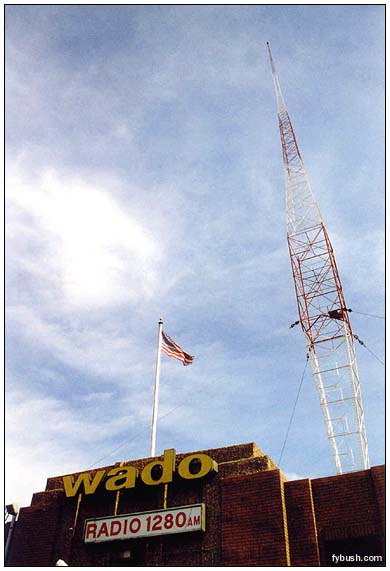
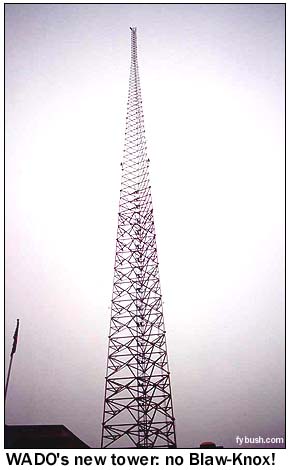 Alas, those five
are now the only places in America to see one of these historic
and beautiful towers, and in a roundabout way you can blame the
FCC's decision to lift the 5 kW power restriction on "regional"
channels like 1280.
Alas, those five
are now the only places in America to see one of these historic
and beautiful towers, and in a roundabout way you can blame the
FCC's decision to lift the 5 kW power restriction on "regional"
channels like 1280.
When that limitation disappeared in the early 1990s, WADO realized that it could dramatically boost its power from the Carlstadt site.
It applied to go to 50 kilowatts by day, 7200 watts at night - but that required a new antenna system.
So not long after this picture was taken, the old Blaw-Knox came down, leaving a much shorter second tower nearby (it had been used for directional night operation.) In its place rose three new towers: the tall self-supporter seen above and two much shorter self-supporters to the north. In this new incarnation, WADO sends most of its 50 kW daytime signal to the southeast, in a lobe that cuts across Manhattan and Brooklyn before heading out to sea. The nighttime pattern is similar, with a bit more power going north towards the Bronx. It's still not a tremendously common DX catch outside New York, thanks to co-channel stations in places like Montreal, Hanover and here in Rochester, but it gets the job done quite well in New York City, which is really all that matters.
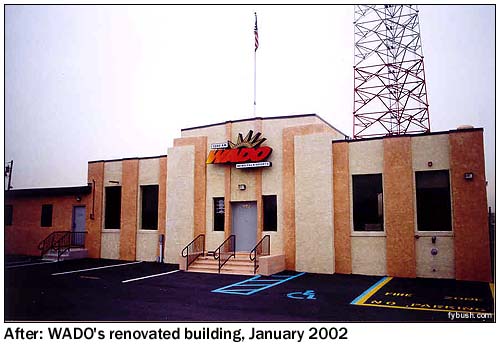 The
engineers at Hispanic Broadcasting did something else when they
rebuilt this site: they completely renovated the 1930s-era building
that houses the transmitters.
The
engineers at Hispanic Broadcasting did something else when they
rebuilt this site: they completely renovated the 1930s-era building
that houses the transmitters.
You can pull up to this site now without being greeted by a rusty barbed-wire fence; in fact, the newly stuccoed building greets the world with big picture windows through which you can clearly see the Harris DX50 transmitter and phasing units inside. (You can see the view below..)
And you've got to love WADO's trademark Statue of Liberty logo, too!
(Not to mention the flagpole that continues to fly from the top of the building...)
The small building off to the left in this picture has a sign on the door that reads "Netmio," which is, if we recall correctly, the on-line arm of Hispanic Broadcasting's stations.
The only real surprise here is that HBC hasn't yet taken advantage of the opportunity to use its new tall tower as an auxiliary site for WADO's sister FM, WCAA (105.9 Newark), as several other nearby AM facilities have long done.
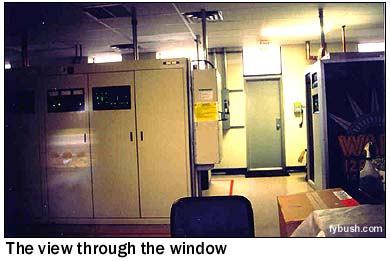
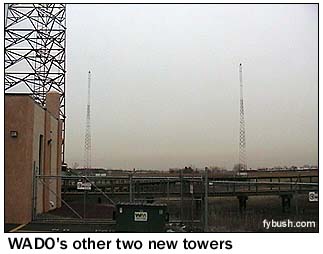
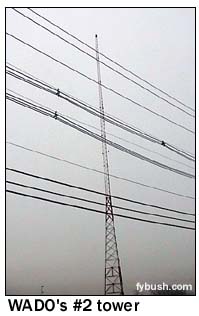
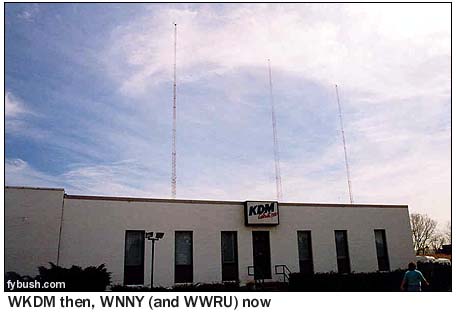
The last remaining vestige of the "old" WADO sits at the east side of the site: tower number two, which has been here for years and remains part of both the day and night arrays.
But WADO isn't the only radio station in this part of the New Jersey Meadowlands, not by a long shot.
Less than a mile to the east down Paterson Plank Road sits a three-tower array with its own long history in New York radio. The station on 1380 moved here decades ago as WBNX, one of several ethnic operations at the upper end of the dial. It became WKDM in the early 1980s, and that's the call it was using when I stopped by in 1998 to take the picture shown above.
It still looks the same from the outside today, but things have changed dramatically inside. Under new owner Mega, the station changed calls last year to WNNY, "Noticias Nueva York," and today programs a news-heavy Spanish format to New York City from studios in Manhattan. (The WKDM studios were, for many years, located out here in New Jersey.) There's also a new tenant in this building: Radio Unica outlet WWRU (1660 Jersey City) uses these towers as well, having moved from its original home at the WJDM 1530 tower down in Elizabeth.
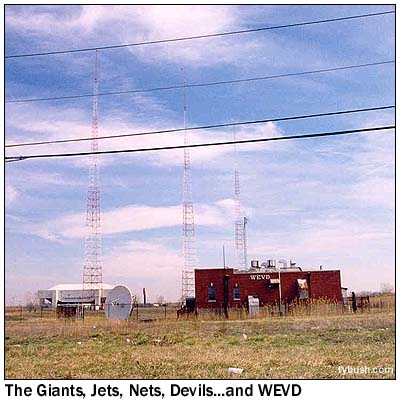 One more site almost
completes our tour of this portion of the Meadowlands: as you
head east on Paterson Plank Road towards the western spur of
the New Jersey Turnpike, the road splits, with a county road
heading north and New Jersey 120 heading south into East Rutherford,
towards the Meadowlands sports complex that's home to Giants
Stadium and the many-named arena where the Devils and Nets play.
One more site almost
completes our tour of this portion of the Meadowlands: as you
head east on Paterson Plank Road towards the western spur of
the New Jersey Turnpike, the road splits, with a county road
heading north and New Jersey 120 heading south into East Rutherford,
towards the Meadowlands sports complex that's home to Giants
Stadium and the many-named arena where the Devils and Nets play.
And as you head south on 120, you can't miss the three towers shown to the left. This, historically, was WHN and WMGM, the 1050 spot on New York's dial. It's had a transmitter site here since December, 1941, and the only thing that's changed dramatically outside is the call on the front of the building.
WHN became WMGM in 1948, then went back to the WHN calls in 1962. Those lasted (as beautiful music, then as country) until 1987, when this facility spent a year as the original home of all-sports WFAN. WFAN's move to 660 in 1988 sent 1050 to Spanish, briefly, as WUKQ until a trade could be completed that gave WUKQ owner Spanish Broadcasting System control of WEVD's old 97.9 FM spot (it's now top-rated WSKQ-FM), while the political talk of WEVD moved back over to AM at this 1050 facility.
That, in turn, came to an end in the fall of 2000, when WEVD became New York's ESPN Radio outlet. And yes, at various times just about every sports team that's played across the road at the Meadowlands has had its games heard on this signal!
One more site will complete our visit to this part of the Meadowlands, but, alas, I don't have a good picture of it. Remember how WNEW left Paterson Plank Road in 1941 when it moved down the dial to 1130? The site to which it moved was a few miles south in Kearney - directly in the path, some twenty years later, of the new western spur of the New Jersey Turnpike! The land (or, more properly, the swamp) was taken by the Turnpike, and in the late sixties WNEW moved back north, building a new four-tower site about a mile east of 1380, north of an oil refinery on Paterson Plank Road on the east side of the new Turnpike spur. It's impossible to access without permission, but we hope someday to get a tour and bring you some pictures. (And in the meantime, why not check out Jim Hawkins' Radio Room site, which does have pictures of the 1130 site, now WBBR, as well as of the other sites shown here?)
We'll continue our look at New York's AM sites at some point with a visit to WWRL, also nearby in Secaucus, and then we'll head north to the WWDJ/WWRV, WZRC and WABC sites. Stay tuned, won't you?
- Previous Site of the Week: Tracking the Rural Radio Network
- Next Week: Jamestown, N.Y.
- How can you help support Site of the Week? Click here!
- Submit your suggestions for a future Site of the Week!
